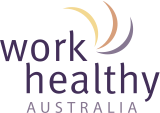
Heavy Industry Worker workman service team working in metal factory Portrait Happy smiling.
Safe Work Month 2025:
Each October, Safe Work Month is a timely reminder of the importance of prioritising health and safety in Australian workplaces. In 2025, the theme ‘safety: every job, every day‘ continues to emphasise the value of proactive, preventative approaches – empowering organisations to embed safety as a shared responsibility and cultural norm.
Safe Work Month presents an ideal opportunity for organisations to engage teams in meaningful safety conversations, reduce risk, and demonstrate a tangible commitment to worker wellbeing. Whether you’re in manufacturing, logistics, government, food processing, or healthcare, fostering a safer workplace begins with practical, onsite action. Here are some suggestions for onsite activities that pack a punch, that you might consider adding into your plan for an October rollout.

Onsite activities that drive impact
1. Workplace Pain Education – Breaking down barriers to recovery
Workplace pain is a common but often misunderstood issue. Work Healthy Australia’s Workplace Pain Education program helps demystify pain and equip workers and supervisors with tools to better understand pain behaviours, communication around injury, and strategies to support peers. In addition to setting the standard for injury management in your workplace, the program offers a solution to a common psychosocial barrier to recovery and supports early intervention principles.
2. Onsite Health Checks – Identify risk early
Preventative health checks offer immediate insights into employee health markers such as blood pressure, cholesterol, glucose levels and BMI. These assessments can uncover early warning signs of chronic disease and open the door for tailored health coaching and support pathways. Implementing onsite health checks during Safe Work Month signals a culture of care and positions health and safety as a strategic priority.
3. Occupational Audiometry – Protecting against hidden hazards
Noise-induced hearing loss remains a silent, long-term risk in many Australian workplaces. Work Healthy Australia provides an Occupational Audiometry solution in alignment with regulatory requirements to detect early threshold shifts and ensure hearing protection programs are fit-for-purpose. Integrating hearing assessments into your Safe Work Month program demonstrates diligence in managing occupational noise hazards.
4. Floor Walks and Manual Task Reviews
Conducting joint floor walks with health professionals and safety representatives during Safe Work Month creates visibility of risks that may otherwise go unnoticed. From identifying hazardous manual tasks to suggesting control improvements, these walkthroughs promote ownership, engage frontline teams, and support continuous improvement.
5. Stretch and Movement Programs – Embedding micro-breaks into daily routines
Onsite stretch sessions, warm-up routines, and movement programs reduce musculoskeletal strain and encourage team-based accountability for injury prevention. Speak to your onsite healthcare provider about tailored stretch programs aligned with job roles and known injury trends, aimed at helping reduce injury risk and fatigue – and improve productivity.
Sign up to our monthly enewsletter
"*" indicates required fields
